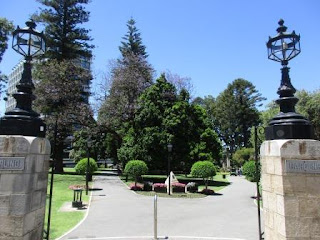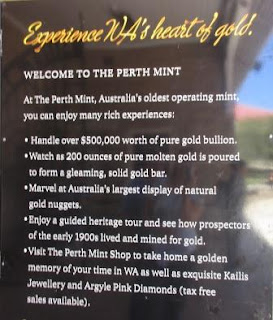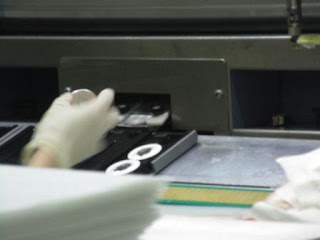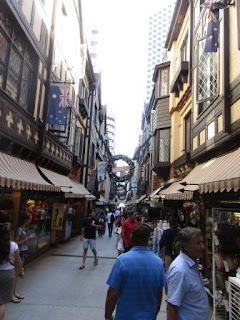Very
windy night. Clear sky. Weather forecast is for 31 today, Cairns is 33, so we
are nearly the same – just the night temperatures are lower, like 13!!
Drove
to Welshpool to leave the truck and board the train. Bit of confusing about
paying the $2 car park fee but I got a nice lady on the phone and we got it
sorted out and all the info about using the train and free buses in town.
Lovely Jacarandas at the train station.
Some
Perth information – In March 1827, Captain James Stirling of the Royal Navy
arrived in the Swan River and discovered a land that possessed great natural
attractions, in contrast to the previous Dutch and French navigators who
described New Holland (a name given to Australia by the Dutch) as sterile,
forbidding and inhospitable. This landing and subsequent report by Stirling to
His Majesty’s Government back in England, led to the foundation of the Swan
River Settlement in June 1829. Using the Swan River for transport, three towns
were formed, Perth, Fremantle and Guildford. Fremantle, 20km downstream on the
coast served as the colony’s functional port and Guildford, 20km to the east
was chose to supply produce to the surrounding region because of the rich, fertile
soil found in the Swan Valley. Experiencing severe labour shortages, the
British sent convicts to WA between 1850 and 1868 to help establish
settlements. 9721 convicts were transported to WA on 43 convict voyages.
Between 1850 and 1868 WA was a Penal Colony. The convicts were involved in a
significant amount of infrastructure such as the Fremantle Prison, Government
House, The Cloisters, the Swan River Mechanics’ Institute and the Perth Town
Hall.
Lovely
clean train carriage and plenty of room. Got off at the main Perth Station on
Wellington Street. The Station opened in 1894 and is fundamental location in
the story of gold in WA. The station was an unloading point for gold
transported from the Goldfields and is one of the oldest operational central train
stations in Australia. The original station was built in 1881, but the railway
network grew rapidly. The station building and platform facilities quickly
proved inadequate and it was replaced by a larger building in 1894. Additional
wings to the east and west were completed in 1897 which double the size of the
station. I love all these buildings – the new modern ones just aren’t as nice.
Across
the road is Forrest Place – named after Sir John Forrest, who was vital in the
development of the gold industry in WA. As State Premier during the gold rush
period, he instigated the water pipeline from Perth to Kalgoorlie, the railway
and The Perth Mint. The artwork is called ‘Grow Your Own’ (2011).
Found
the Information Booth and got all the history walks etc. More lovely buildings
like The Commonwealth Bank.
The
General Post Office was built between 1914 and 1923. It was the tallest
building in Perth at the time of its construction. Isolated prospectors would
send their gold by post to the General Post Office where it would be forwarded
to The Perth Mint. The Mint would refine the gold and then send payment to the
Post Office for the prospector to collect. Amazing to think no one stole their
gold or their money on route!! The Post Office building is under renovation so
we couldn’t go in. Found a few information boards but they were quite scratched
and hard to read.
Lots
of Christmas decorations and on the weekends the Outback Christmas area will be
alive with activities.
Went
into Myer to see their Christmas decorations. Shame they don’t do the front
windows up.
Steve
looks where he walks and found a history plaque about Solomon Cook who had his
foundry at this spot in 1861 – he would be amazed at what is here now.
In
David Jones we found another ‘cow’.
Found
another interesting history plaque about camels.
The
Perth Town Hall took three years to building using convict labour and had its
formal opening on 1 June, 1870. The undercroft formed a covered marketplace
that operated for a few years before it became too costly. The space was later
used to house the city’s firefighting equipment, including a 12-man fire
carriage. The firefighters were located some distance away and the horses were
tied to taxis. In the event of a fire, the Town Hall bell rang out and the
burly firefighters would dash up to the Town Hall, while the taxi drivers
harnessed their horses to the fire equipment. This economical arrange meant the
service was not entirely efficient! Aside from these practical uses, charity
events, balls and civic ceremonies were held in the Hall. The man who became
known as “Father of the Kimberley”, Alexander Forrest, was sworn in as Mayor of
Perth at the Town Hall in 1892 and he held office for six years (1892-95 and
1897-1900). One of the more unusual uses of the Town Hall was as a camel
stable! Explorer Ernest Giles used the undercroft as a resting place for his
camels on his epic journey from South Australia in 1875, creating much
excitement among Perth’s residents. The original brickwork was originally laid
in Flemish bond, with its distinctive chequerboard pattern of light stretches
and dark header bricks. The original bricks came from the former East Perth
clay pits, now the site of Queen’s Gardens. Major restoration works were
carried out in 2005.
On
one of the piers was another sign about Telegraph Communication.
Next
to the site of the Town Hall a tree was felled marking the founding of this
city in 1829.
McNess
Royal Arcade (1897) is a great demonstration of the wealth that poured into
Perth from the Goldfields. Designed by American architect, William Wolf, it was
described as an extravagant building with a generously designed interior and
exterior. The owner of the building, Charles McNess, was a scrap metal trader
and ironmonger who made his fortune during the gold boom by purchasing
property, eventually expanding into mortgage broking.
Alexander
Forrest on the corner to the entrance to Stirling Gardens.
The
Central Government Offices or Treasury Group is a group of three buildings
including the original General Post Office (1889), the Lands Department (1893)
and the Titles Office (1897), which reflect the 19th century custom
of keeping government departments centrally located. The corner of Cathedral
Avenue and St Georges Terrace marks Point Zero, the point from which all
measurements of distance from Perth are still taken.
Here’s
a pure example of the beautiful old architecture versus the boring modern
architecture.
In
Stirling Park we found some friends.
Interesting
collection of rocks.
St George’s
Cathedral was completed in 1888. Not sure about the modern art in front though.
Down
through the gardens to the Supreme Court of WA. It was opened in 1903 and the
first case heard there resulted in Robert Palin, and ex-convict, being
sentenced to death for robbery with violence. Eric Edgar Cooke, the last person
hung in WA, was tried and convicted for murder at the Supreme Court in 1964.
Across
to Barrack Square and The Bell Tower. Lots of love locks hanging here.
The
tower was opened in 2000 as WA’s Millennium project. The tower includes the
twelves bells of one of London’s most famous churches, St Martin-in-the-Fields,
and are recorded as being in existence from before the 14th century
and recast in the 16th century by Queen Elizabeth I. In the mid
1980’s the historic bells were in poor condition and causing structural
problems to the church tower. Consequently they were scheduled to be melted
down and re-cast. When Laith Reynolds heard of this, he and others commenced
lengthy negotiations with the church and civil authorities in London with the
intention of obtaining the bells. Approval was eventually given for an
alternative plan where the old bells would be saved, retuned and sent to Perth.
In return 13 new bells were cast with virgin Australian copper and tin for the
Church of St. Martin-in-the Fields, London.
Inside
was a clock mechanism too.
I
joined others for a bell-ringing tour. This is the oldest bell in Australia and
has a big crack in it. It is said that if you rub the crack it will give you
good luck – hence I gave it a big rub.
Learnt
all about ringing bells – need a good memory to remember the sequences of the
bell pulling. There were bats in the belfry too!
We
only made the bell chime – as we pulled the rope up and down it didn’t make a
sound but then we held it and the clapper (where the saying ‘going like a
clapper’ comes from) struck the bell. We could see the bells moving on the TV
screen. I took videos of the others ringing the bells. When the bellringers
pull the rope they have the bell upside down and then it does the big swing
around making the ring.
I even
got a certificate!!
Great
view over the Swan River from up here.
Then
the actual bell-ringers arrived and got the bells going. We could watch them
through the dark windows (no good for photos) but I took a photo of them off
the TV screen.
Up
the stairs for lots of videos of the bells swinging – sounded wonderful.
Lots
of information as well.
The
bells have names – the biggest one, Zachariah, weighs 1480kg but it is only the
third largest swinging bell in Australia.
Found
Steve on the boardwalk then wandered around reading all the history
information.
Steve,
of course, found the birds!!
This
big copper ring has 200,000 signatures etched on it which were collected in
1999 from nearly every school student in WA. Originally the signatures were on
tiles around the base of the Bell Tower but were moved in 2015 as part of the
revitalisation project of the Barrack Street Jetty.
Moored
nearby was the Duykfen. They had the 400th anniversary of the Dutch
arriving at Shark Bay in October.
We
checked out the Venetian Canals in Mandurah the other day – they need one of
these down there. $15 for a 20 minute cruise.
Walked
across an interesting bridge at Elizabeth Quay with a great view to the city.
Interesting
bit of art.
More
information to read.
I
wonder which company is having their corporate Christmas party here – it is
called Quay to the Caribbean.
The
BHP Billiton water park is under renovation but I put the camera over the fence
for a photo.
A
bit more info.
Beautiful
bit Christmas Tree which is covered in 55,000 lights – one for every person who
called Lifeline WA this year.
Headed
up Hay Street towards The Perth Mint. Statue of Capt Stirling.
Only
the portico remains of St George’s Hall. The District Court Building is behind
it.
Lots
of big building constructions happening in town too.
I
wonder if they have someone in there waiting to go to the District Court up the
road!!
The
Perth Mint is Australia’s oldest operating mint.
The
two men who started the gold rush in WA.
History
on the entrance doors.
When sovereign production ceased in 1931, The Perth Mint had produced 106 million sovereigns and 735,000 half-sovereigns from the gold mined in the State. Then during the early 20th century, it turned its minting expertise to producing large quantities of Australia’s circulating coins, including many of those for the launch of the nation’s new decimal currency. In total, 438 million pennies, 256 million half-pennies, 1.3 million shillings, 829 million two cent pieces and 26 million one cent pieces passed through its presses. In 1970, ownership of The Perth Mint was transferred from the British Government to the Government of Western Australia, who originally funded its construction. Managed by Gold Corporation and under the authority of the Commonwealth Department of Treasury, The Perth Mint is now the official producer of the Australian Precious Metals Coin Program. Issuing some of the most significant and highly sought-after legal tender bullion and commemorative coin programs ever seen, The Perth Mint is a world leader in the global coin market. The Perth Mint also refines the total of Australia’s gold production and gold sourced from surrounding countries. It manufactures and markets a wide range of cast bars and semi-fabricated forms of gold and silver for trading, and offers precious metal investment options and storage facilities. Although The Perth Mint never fell prey to a large robbery through the gold boom years, small thefts occurred. One of the supervisors, Mr William Dar, forced workers to stay back late on a number of occasions searching for missing gold which he accused them of stealing. The gold was never found and it was later discovered that Mr Dark himself was the culprit, slipping the gold into his pocket!
When sovereign production ceased in 1931, The Perth Mint had produced 106 million sovereigns and 735,000 half-sovereigns from the gold mined in the State. Then during the early 20th century, it turned its minting expertise to producing large quantities of Australia’s circulating coins, including many of those for the launch of the nation’s new decimal currency. In total, 438 million pennies, 256 million half-pennies, 1.3 million shillings, 829 million two cent pieces and 26 million one cent pieces passed through its presses. In 1970, ownership of The Perth Mint was transferred from the British Government to the Government of Western Australia, who originally funded its construction. Managed by Gold Corporation and under the authority of the Commonwealth Department of Treasury, The Perth Mint is now the official producer of the Australian Precious Metals Coin Program. Issuing some of the most significant and highly sought-after legal tender bullion and commemorative coin programs ever seen, The Perth Mint is a world leader in the global coin market. The Perth Mint also refines the total of Australia’s gold production and gold sourced from surrounding countries. It manufactures and markets a wide range of cast bars and semi-fabricated forms of gold and silver for trading, and offers precious metal investment options and storage facilities. Although The Perth Mint never fell prey to a large robbery through the gold boom years, small thefts occurred. One of the supervisors, Mr William Dar, forced workers to stay back late on a number of occasions searching for missing gold which he accused them of stealing. The gold was never found and it was later discovered that Mr Dark himself was the culprit, slipping the gold into his pocket!
Wandered
around checking out all the gold, gems (eg. Argyle Pink Diamonds) and coins. We
can sell our gold here too!! Paid for a tour. First was the one tonne pure
(99.99%) gold coin valued at more than $50 million at the moment. It was made
in 2012.
Lots
of gold nuggets in here.
The
Newmont Normandy Nugget weighs 25.5 kg (819oz) was found in 1995 is still the
second largest in existence and was found near Kalgoorlie in a dry creek bed. Normandy
Mining, now part of Newmont Asia Pacific, purchased the nugget in 2000 after
the Commonwealth Government prevented attempts by its finder to sell it
overseas due to its cultural significance. Ownership of the nugget ensures that
it stays in Australia as an important part of our mining heritage. The nugget
is estimated to be 40 million years old and 80-90% high purity gold.
In
another vault were lovely bars of gold. Watched a video on the bad side of gold
– theft and murder.
In
the next vault was a nice nugget we tried to take home but someone put a big
bar over it! We both managed to lift it up.
Next
we watched a gold bar being poured in the original Melting House though now
they use natural gas furnace instead of wood-fired. The refining of gold in
this room though ceased in 1990, when the process was moved to a purpose-built
facilty. During its 91 years of operation, 2596 tonnes of gold went through
this room. The brick walls and ceiling are literally embedded with gold dust.
The
gold bar is melted and poured many times a day and the chap said each crucible
was worth $100 and only lasts 2 weeks. They are sent to the refinery though and
melted down to extract the little bits of gold and usually they get $200 of
gold back from each one which is then added back to this bar again.
Took
a video of him lifting out the melted gold and pouring it into the bar. The
gold bar poured and then into water to cool – ready to touch in a few minutes.
Info
about making coins, looking through to the machinery and a few old coin
presses.
Back
into the Museum section where they had scales to see what we are worth in gold.
Always knew I was worth a lot!!
Lots
of information to read.
Would
love some of these.
Staff
creating new coins in the Coining Department.
So
the gold medal is actually silver with 6 grams of gold plated onto it.
Got
onto one of the free CAT Buses for a ride back to the malls. Wandered back down
Hay Street Mall. Percy Button was a street performer who was a familiar sight
in Hay Street during the 1930-40s where he would entertain the queues of people
waiting to attend the cinemas.
The
Theatre Royal built in 1897 was the first purpose built theatre in WA. The
locals considered the theatre exceptional for its time, with its ‘red plush and
glitz, and a roof that could slide open on hot nights’. Thomas Molloy built the
Theatre next to his Metropole Hotel, and went on to create the landmark His
Majesty’s Theatre less than a decade later. Molloy, the son of a Pensioner
Guard, started his working life as the manager of Cooperative Stores in Perth,
then became a baker in Goderich Street. He grew to be a prominent member of the
community, serving terms as Town Councillor, Mayor and as a member of the
Legislative Council. However, many believed that his greatest achievement was
the introduction of barmaids to Perth!!
London
Court is a lane running between Hay Street and St George’s Terrace. It is a
mock Elizabethan reproduction of an old London street and was built in 1937 as
a gift to Perth by the charismatic and debonair millionaire, Claude de
Bernales. He made his fortune buying and selling mining equipment in the
Goldfields, although his business practices were questioned when the machines
gained a reputation for poor quality and his acceptance of mine leases in
payment for machines angered the miners. Despite this, he always focussed on
making a good first impression on the miners, changing into a full business
suit carried in a suitcase on his bicycle before cycling into each miner’s
camp. It was amazing. There were ships on the ceiling of the entrance and
everything was so English.
Another
nice laneway where a church service was held in 1830 under a Jarrah tree.
Another
front from the old days kept and a new building put behind it.
Nearly
back to the Station – not sure what this building was.
Back
into the railway station – now to find our ride home.
Back
to our truck. On the way home we drove up into Perth Hills for a look. Found a
lookout – bit hazy over the city. Will come back up for a sunset photo.
It
was 35 degrees in the van so got all the windows open to cool down.
Quiet
night resting our feet – need to get back into tourist mode!!






























































































































































































No comments:
Post a Comment